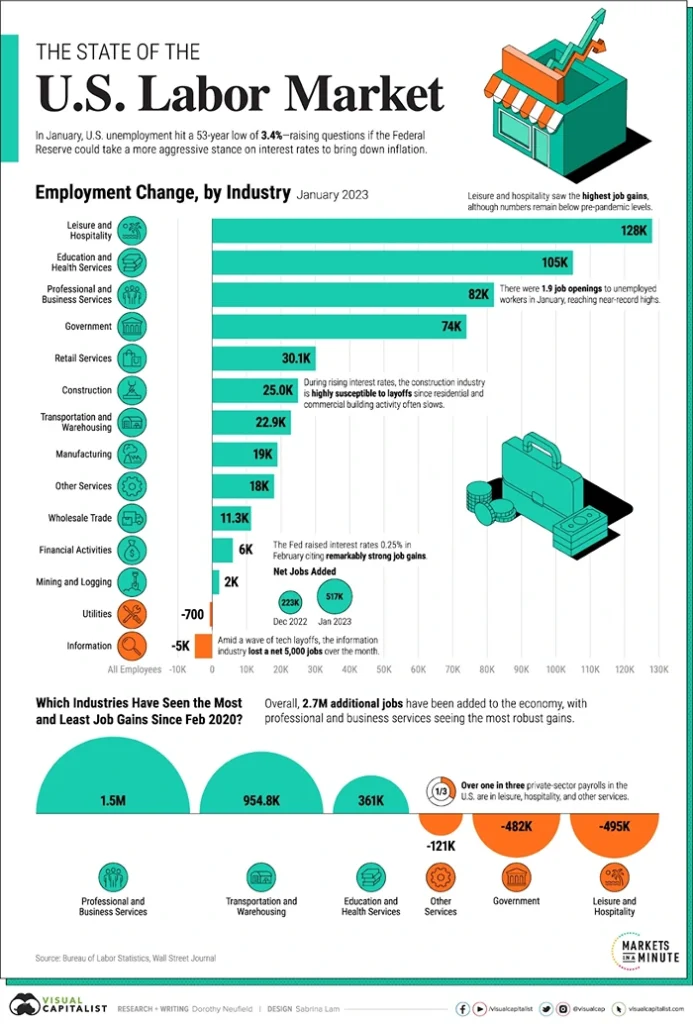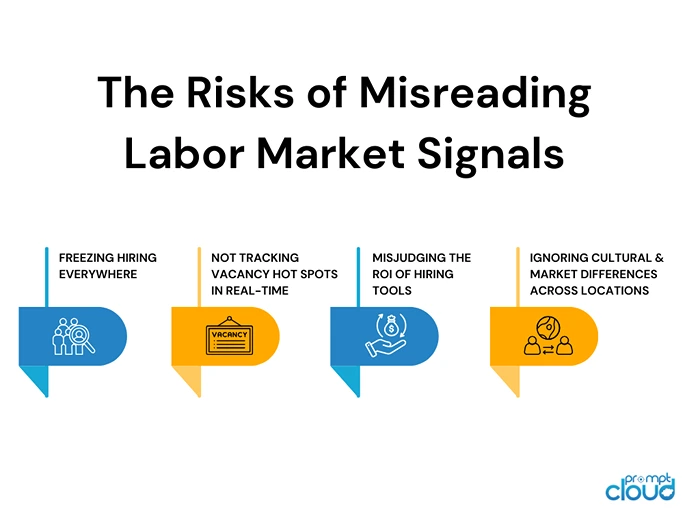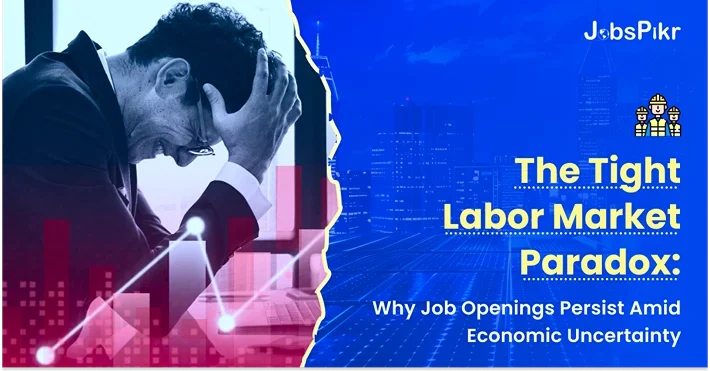- **TL;DR**
- A Labor Market That Won’t Slow Down
- What Does A Tight Labor Market Mean?
- Economic Uncertainty vs. Hiring Demand: Why They Coexist
- Where the Labor Market Is Still Strong
- Why Employers Can’t Fill These Roles
- The Risks of Misreading Labor Market Signals
- Smarter HR Workforce Planning in a Tight Market
- Seeing Through the Noise
- FAQs:
**TL;DR**
You’d think companies would stop hiring when the economy is shaky. But there are still a ton of jobs sitting open. And it’s not because businesses are being reckless. They genuinely can’t find people to fill certain roles.
You’d think companies would stop hiring when the economy is shaky. But there are still a ton of jobs sitting open. And it’s not because businesses are being reckless. They genuinely can’t find people to fill certain roles.
That’s what makes this a tight labor market. It’s not just about more jobs than people; it’s that the right people aren’t showing up. Folks with specific skills are hard to find right now. And for some industries, like healthcare or logistics, there’s no way to just “wait it out.” They have to keep going.So, while some sectors are hitting pause, others are stuck trying to fill positions that are too important to leave empty. This article unpacks what’s going on and why some companies are hiring like nothing’s wrong, plus how better workforce planning and sharper data can help them spend less while still finding the right talent.
A Labor Market That Won’t Slow Down

Image Source: Buildforce
It’s been a weird couple of years for hiring.
One minute, companies are laying people off. Next, they’re scrambling to fill roles. If you’ve been trying to make sense of what’s going on in the job market lately, you’re not alone. A lot of people, even inside companies, are confused by how we got here.
Here’s what we do know: the U.S. labor market isn’t following the usual script. You’d expect hiring to cool down when the economy starts looking shaky. But instead, there’s still a steady stream of job openings across the board. Not in every field, sure. But enough to make you stop and go, “Wait… didn’t we just hear about a slowdown?”
This is what folks are calling a tight labor market. And it’s not just a fancy term economists throw around. It’s a real thing — when there are more job openings than available workers, especially for roles that need specific experience or training.
Now, this isn’t just about employers being picky. It’s a mix of things. Some workers left the workforce early — a lot of older employees decided not to come back after the pandemic. Some switched industries completely. And in many cases, the skills companies are looking for just don’t match what job seekers have right now.
So here we are: too many roles, not enough people. Companies are trying to grow or simply keep things running, but the talent pool hasn’t caught up. And when hiring slows in one area, another seems to pick up. It’s uneven and unpredictable, and that’s what makes this labor market so tricky to navigate.
If you’re in HR, finance, or anywhere near hiring decisions, this isn’t just an interesting trend. It’s something that needs attention — fast. Mess up your hiring decisions now, and it’s not just a small setback—it can drag out timelines, burn through budgets, and make things way harder later. That’s why HR workforce planning isn’t just some trendy phrase. When things get unpredictable like this, it’s one of the few tools that actually helps companies stay steady.
What Does A Tight Labor Market Mean?
The term gets thrown around a lot lately — “tight labor market.” But what does that actually mean? And why should anyone outside of an econ class care?

Image Source: BLS
More Jobs Than People
At its core, a tight labor market just means that there are more job openings than there are people actively looking to fill them. It sounds simple. But the reasons behind it? Not so much.
It’s not just about too many jobs. It’s about the wrong kind of mismatch. There are workers out there, but they may not have the skills companies need, or they might be in the wrong location. Others might’ve left the workforce entirely, especially during and after the pandemic. In fact, labor force participation in the U.S. is still below pre-2020 levels. That might not sound like much, but when you spread that across the entire economy, it creates real gaps.
Retirements, Burnout, and People Switching Gears
Part of the problem is that a big chunk of experienced workers simply tapped out early. A lot of baby boomers retired ahead of schedule, and younger workers have shifted priorities — changing industries, going freelance, or just rethinking what kind of work they want to do.
You’ve also got the burnout factor. Healthcare workers, for example, have been running at full tilt since 2020. Many of them have either left the field or scaled back. And those roles? Not easy to replace. You can’t just hire someone off the street and put them in an ICU. The same goes for specialized tech roles or skilled trades. There’s training involved — and that takes time.
Why This Isn’t Just a Temporary Thing
Some folks still think the labor market will “normalize” soon. But let’s be real — this isn’t a blip. We’re dealing with structural changes. The U.S. is aging. Education systems aren’t producing enough candidates in high-demand fields. Immigration policies are tighter. And automation? That’s not filling the talent gap yet — at least not fast enough.
So when we say the labor market is tight, we’re not just talking about a rough quarter or two. We’re looking at long-term shifts. And for people in charge of hiring, budgeting, or workforce planning, this is the kind of thing that needs a strategy, not just a reaction.
Economic Uncertainty vs. Hiring Demand: Why They Coexist
It feels strange, doesn’t it? You flip through headlines about layoffs, interest rates going up, or companies tightening budgets — and then, right underneath, there’s news about thousands of job openings in healthcare or tech. So which is it? Is the economy slowing down, or are we still hiring?
Turns out, both are true.
Not All Sectors Feel the Pain at the Same Time
When people talk about the economy being shaky, they’re often thinking in broad strokes — GDP, stock markets, maybe consumer spending. But job demand doesn’t always follow the same rhythm as the economy. A company might tighten up its budget in some areas but still keep hiring in others. If a role keeps the business running day-to-day, they’re not going to hit pause just because the market’s shaky.
Take logistics, for example. Demand there hasn’t slowed down much, even with inflation and global uncertainty. Same with healthcare. People still get sick. Supply chains still have to move. And companies can’t afford to stall hiring in those areas, even if they’re trimming costs elsewhere.
Recession Fears Don’t Always Equal a Hiring Freeze
Here’s something that often gets missed: hiring can stay strong in certain roles even when the economy hits a rough patch. Why? Because some jobs don’t just support growth — they support survival. Tech infrastructure, skilled trades, cybersecurity, compliance… these aren’t “nice to have” jobs. They keep the lights on.
So while companies might delay hiring in sales or marketing, they’re still desperate for back-end engineers or specialized healthcare staff. This unevenness is part of what’s fueling the current tight labor market. It’s not about every company going full-speed — it’s about some of them not being able to stop, even if they want to.
Why Hiring in Uncertain Times Looks Different
Companies are hiring, sure. But how they’re hiring has changed. There’s more scrutiny around spend, more demand for clear ROI on every new hire. It’s not about volume — it’s about precision.
That’s where HR workforce planning starts to matter more. Decision-makers aren’t just asking “Can we afford to hire?” They’re asking, “Can we afford not to hire for this specific role?” And that’s a totally different conversation.
Good hiring strategy in this climate isn’t just about staying aggressive — it’s about being smart, using workforce intelligence to see where the real needs are and which roles will drive stability through the chaos.
Where the Labor Market Is Still Strong
Even when the overall economy looks shaky, some sectors keep plugging away, hiring like there’s no slowdown. Let’s break down where demand is still hot.

Image Source: Visual Capitaliist
Healthcare and Education: Backbones That Don’t Stop
The U.S. added 39,000 healthcare jobs just in June 2025, on top of long-term trends that have been steady for months. These jobs aren’t just popping up for a season and fading away. Healthcare roles—whether it’s nurses, clinic staff, or back-office folks—are needed everywhere, all the time. And education? Especially in public schools and local programs, there’s steady hiring there too. It’s not flashy, but it doesn’t stop.
These sectors never fully “pause.” People still get sick, babies still get born, and schools still have classes. That means ongoing openings—even when other businesses pull back.
Logistics, Warehousing, and Supply Chains Keep Rolling
Warehousing and transportation saw about 29,000 job gains in April, and transport overall kept climbing through June. Almost every retailer, factory, and online shop depends on these roles. When boxes still need moving or parts must arrive on time, companies don’t stop hiring.
Inflation and global uncertainty haven’t removed the need for trucks, docks, and inventory management. If anything, they’ve made it clearer: chaos in logistics means chaos everywhere else.
Tech, Cybersecurity, and Skilled Trades
Even though hiring in the private sector cooled a bit in June, certain jobs haven’t missed a beat. Roles tied to tech—stuff like cloud systems, cybersecurity, backend ops—are still getting snapped up. You don’t always see those numbers on the surface, but companies rely on these folks every day. Without them, things break, data leaks, or teams can’t keep up with automation.
Same story with hands-on trades. Electricians, HVAC techs, machinists—there just aren’t enough of them around. A bunch of experienced workers took early retirement over the past few years, and the pipeline hasn’t caught up. Trade schools can’t crank out replacements fast enough.
Job Openings Still Top 7.7 Million Nationwide
Despite cooling in some areas, there were still 7.77 million job openings in May 2025—about 4.6% of all roles, according to the BLS Statista. That’s close to the six million people officially listed as unemployed. So yes, there are more roles than job-seekers in many cases.
Why This Matters for CFOs and HR Tech Buyers
If you’re deciding where to spend on hiring—say, with ATS tools, headhunters, or training—you need to know what jobs are going to stick around. Industries like healthcare or logistics aren’t a flash in the pan; they have persistent needs. Investing in workforce intelligence here lets you focus your dollars where hiring challenges aren’t going away anytime soon.
Why Employers Can’t Fill These Roles
Lots of companies are sitting on open roles, but they can’t fill them. And it’s not all about pay. There are deeper issues at play that are reshaping hiring.
Ninety-Three Percent of Employers See Talent Shortages
Around 75% of U.S. employers say they are struggling to fill job vacancies, and 70% report significant labor shortages in 2025; that’s not a drill—this is the second-highest rate in nearly two decades.
That lack of available candidates stretches across industries—tech, manufacturing, healthcare, and logistics. It’s a systemic problem.
But It’s Not Just A Numbers Thing—Skills Don’t Always Match
Take manufacturing: about half of open positions now require a bachelor’s degree, even though these jobs were once more hands-on. And even when a job doesn’t require a college degree—like forklift operators or maintenance technicians—companies still can’t find applicants with the right training or experience.
For middle-skill roles—positions that need certificates or associate degrees—there are still roughly 1.2 million jobs left open, costing the U.S. economy about $150 million per year, That’s not rounding issues—that’s real economic impact.
Retirements and Demographics Are Shrinking Your Talent Pool
Baby boomers are retiring faster than younger workers can replace them. As of 2025, prime-age labor participation hit 83.6%, but participation for older workers remains 5 points below pre‑pandemic levels.
And don’t forget immigration. Hiring managers are digging deeper into the domestic talent pool while legal and political pressures are tightening the pipeline.
Low Pay and Poor Conditions Push People Away
It’s not always about missing skills—sometimes it’s about missing incentives. Reddit users have pointed out that many people won’t take physically tough, low‑pay jobs simply because they aren’t worth the effort.
Look at construction or factory jobs: even with tariffs aiming to bring them back, younger workers are uninterested if the pay doesn’t match the effort, or if the roles lack flexibility or safety.
What This Means for HR and Recruitment
All of this adds up to a pretty chaotic job market. Companies can’t just post listings and hope for the best. They need:
- Clear demands around skills matching
- Competitive compensation and working conditions
- Deep workforce intelligence to know where talent is in supply/demand imbalance
- Strategic HR workforce planning to prioritize hiring for roles that keep the business running—even if the economy is shaky
Failing to tackle these supply-side issues head-on means longer vacancies, higher costs, and missed opportunities—even when the labor market is technically “tight.”
The Risks of Misreading Labor Market Signals
Companies that don’t really understand what’s happening in today’s labor market risk making costly mistakes. Let’s break down the common misreads and why they matter.

Freezing Hiring Everywhere
It’s easy to see headlines about layoffs or GDP dips and hit pause on hiring across the board. But that blanket approach can backfire, especially if you’re in industries that are still growing.
For instance, when manufacturing roles took a hit during earlier slowdowns, some companies still posted gains. Jobs like machinists and skilled maintenance workers saw growth compared to prior years, according to the BLS. Slowing down hiring in those roles doesn’t just delay projects—it can stall operations and hit revenue.
Not Tracking Vacancy Hot Spots in Real-Time
One of the biggest mistakes companies make right now? Relying on outdated or overly broad job market reports. By the time those national stats show up, they’re already a few weeks behind—and that’s enough time for everything to change. A supplier goes down, a new tool rolls out, or workers shift to other opportunities. Suddenly, the hiring plan you had last month is out of sync with reality.
That’s why the smartest teams are leaning into real-time insights. Instead of waiting around for lagging reports, they’re using live dashboards, vacancy trends, and even what competitors are doing to make quicker calls. If there’s a hiring crunch brewing for a certain role, they see it early, and they move before salaries jump or the best people are off the market.
Misjudging the ROI of Hiring Tools
Recruitment tech can feel expensive. But freezing investment in applicant tracking systems, candidate sourcing tools, or analytics platforms can hurt more in the long run. One estimate shows hiring costs soar up to 40% higher if talent acquisition lacks data-driven tools.
Companies that wait to adopt smarter hiring platforms end up paying more through agency fees, slower fills, and sometimes lost revenue when key roles stay open too long.
Ignoring Cultural and Market Differences Across Locations
Labor conditions look different depending on where you are. A role that’s easy to fill in Dallas might be a nightmare in Pittsburgh. But national stats lump everything together. You can’t treat the whole job market like one big bucket. What’s true in one city or industry might be totally off in another. If you don’t look at hiring by region or role, you might assume there are more good candidates out there than there actually are. Or worse, you might offer pay that doesn’t even come close to what folks in that area expect.
That’s why using HR tools with local insight really matters. They don’t just tell you where jobs are; they show you what’s happening on the ground. What people are getting paid, what kind of benefits matter in that spot, and how competitive your offer really is. It’s not just smarter—it’s necessary if you want to land the right people.
Smarter HR Workforce Planning in a Tight Market
Let’s be honest—most hiring plans don’t hold up well when things get weird. And right now? Things are weird. Roles are staying open for months, budgets are all over the place, and HR teams are under pressure to “do more with less.” Sound familiar?
If you’re still using last year’s hiring playbook, it probably isn’t cutting it. Things aren’t how they used to be. Did the strategies get results last year? They’re not landing the same way now, especially in areas where finding good talent feels like chasing shadows, or where pay expectations have suddenly shot up without warning.
This is where planning gets real. Not the high-level stuff in a PowerPoint—actual, on-the-ground planning. Like knowing which roles can wait and which ones, if left unfilled, will quietly wreck your quarter. Or figuring out where you’re overpaying for talent just because you don’t have a clear picture of what the market looks like outside your zip code.
You also have to stop throwing the same budget at every role. Some jobs are mission-critical. If you’re short a nurse, an HVAC tech, or a backend engineer—those aren’t “nice to have” roles. They keep things moving. If they sit open too long, the cost isn’t just in recruiting—it’s in lost revenue, burnout, and churn.
And it’s not just about money. A lot of companies are missing good candidates because they’re not open to adjusting work conditions—remote work, flexible shifts, stuff like that. Sometimes you’re not short on talent; you’re just not meeting it halfway.
What really makes the difference is having data that doesn’t lag. You need to know what’s happening right now. Who’s hiring? Where’s demand spiking? Trying to hire a data analyst? What you’ll pay in Tampa might look totally different from Denver. And if you don’t have that info up front, you could end up either overbidding or worse, wasting time on roles nobody’s taking.
If you don’t have a system that shows you those trends in real time, you’re flying blind. And right now? That’s a gamble most teams can’t afford.
Seeing Through the Noise
There’s a lot of noise around the job market right now. Some say we’re heading for a downturn. Others point to record numbers of open roles. And somehow, both are true. That’s what makes this current moment so tricky. It’s not just one clear trend. It’s a split screen.
For HR teams and business leaders, the biggest mistake isn’t acting too quickly—it’s waiting too long. A tight labor market doesn’t mean every job is in demand. It means the roles that matter most are getting harder to fill, and that delay comes with a real cost.
Now’s not the time to throw darts and hope for the best. You need to know what’s happening out there. Which jobs are getting filled? Where are companies struggling to hire? And how does your own hiring pace compare to the rest of the market? The teams paying attention to those details are the ones adjusting fast. The rest? They’re falling behind, whether they see it yet or not.
If you’re trying to make hiring decisions that hold up in this environment, you need data that’s live, local, and actionable. That’s where JobsPikr comes in. Our workforce intelligence platform helps HR teams and talent strategists see what’s happening in real time. From job trends to demand gaps, we give you the visibility to plan smarter and spend less.
Don’t just survive the tight labor market. Use JobsPikr to get ahead of it.
FAQs:
1. What is a tight labor market, and why does it matter?
It’s when there just aren’t enough people to fill the jobs that are out there. Simple as that. Employers end up waiting longer to hire, and when they do find someone, they’re often paying more than they planned. It makes running a business harder, especially when you can’t afford delays.
2. Why are there so many job openings even when the economy isn’t doing great?
Not every part of the economy slows down at the same time. Some industries just can’t stop hiring—healthcare, logistics, infrastructure—those jobs need to be filled no matter what’s going on financially. So while headlines might talk about a slowdown, in some places, it’s still full steam ahead.
3. How can HR workforce planning help in a tight labor market?
It’s really about being prepared. Instead of reacting when someone quits or a new project comes up, you already have a plan. You know where you’ll need people, what kind of roles are hardest to fill, and how long it might take. That kind of head start makes a big difference.
4. What’s causing the labor market to stay tight?
It’s a mix of stuff. Some people left the workforce during the pandemic and didn’t come back. Others changed careers completely. And in a lot of industries, the roles that are open need specific skills—not everyone has those. So you’ve got jobs sitting open and not enough qualified folks to take them.
5. Which types of jobs are still in high demand right now?
You’ll see a lot of action in healthcare, tech support, anything logistics-related. Also roles tied to clean energy and data. These aren’t just nice to have—they’re essential. So even if the economy is a bit shaky, those jobs stay on the “must-fill” list.
6. What’s the risk of ignoring workforce intelligence data?
If you’re not looking at the data, you’re flying blind. You might double down on hiring for roles where demand has already dropped—or completely miss where the talent is moving. That kind of mistake isn’t just costly. It can leave you short-handed when it matters most.




